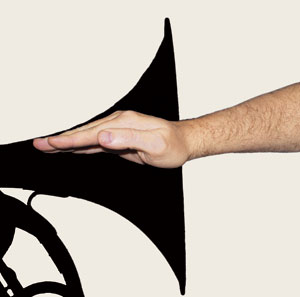What’s so difficult about putting the right hand in the horn bell? Plenty, if you are teaching beginning players. Playing with incorrect hand position in the bell is endemic among young horn players. There are two main areas to address in putting the right hand in the bell – the correct position and best way to teach it to young students.
Lessons From History
A short history of the horn will be helpful in forming an opinion on the correct position of the right hand. In the mid-18th century, before the invention of the brass instrument valve, horn players began to insert the right hand into the bell as a way to change the instrument’s pitch by opening and closing the opening to the bell.
Anton Joseph Hampel is generally credited with having developed a technique that was initially applied to the valveless natural horn somewhere between 1750 and 1760. Known as hand stopping, this technique allowed musicians to sound notes outside the instrument’s normal harmonic series, producing a fully chromatic scale.
When valves were first developed, they were used only as a quick crook change and applied to the left hand because most of the action was still with the right hand in the bell. This is why the horn is the only left-handed instrument in the orchestra. In addition, composers were slow to adopt fully chromatic horn parts because they would have been difficult to play on the hand horn.
There was also a long tradition of teaching the natural horn first before going on to the more expensive valve horn. Two of the greatest pedagogues in the latter part of the 19th century, Oscar Franz and Henri Kling, began their methods with natural horn, proceeding to hand horn and finally valve horn, half a century after the invention of the valve.
Pitch and Hand Position
The point of this history is to show that hand position was always applied in the context of changing pitch through hand stopping, prior to playing the valve horn. This is true both chronologically in history and by pedagogical choice, even after the development of valves. Therefore the hand position should reflect its origins with the hand horn. An historically correct hand position begins with the mandate for changing pitch. Kling explained the mandate:
The player must endeavor to produce these Stopped Notes as clearly as possible, and the difference in tonal quality between these and the Natural Tones must be equalized as much as possible; the Stopped Tones must not sound as though a cloth had been introduced into the instrument.
This mandate to change pitch should also include a minimal difference between open and closed tones.
Because of a resurgence in historically informed performance on the natural horn, there is little doubt that the hand position should make the sound about a quarter-step flatter than with the hand out of the bell. If the hand is too far out, the tones are too dissimilar; if the hand is too far in, the tone is too covered.
Extending the inside of the convex bell with a concave hand at a spacing of about two inches produces a sound that is neither too open nor closed with a stable scale, particularly in the upper register. To facilitate quick pitch changes outside the natural harmonics, the hand has to open and close like a door with the knuckles acting as hinges.
Modern professional horn players use the same hand movement to fine tune individual notes, produce a tightly stopped brassy sound, or give the impression of distance with a loose seal of the bell producing an echo horn effect. The same movement is also used at the periphery of the range with the hand more open in the low register so the notes are stronger and clearer and more closed in the extreme upper register to stabilize the pitches.
Good Hand Position

Ideally the hand should also be in a position to hold the horn off the leg or to stand; however, there is also a small and waning school of horn playing that uses a different hand position better suited for sitting and playing with the bell on the leg. To hold the bell off the leg, support it on the thumb and index finger with the thumb positioned at 12 o’clock and the finger knuckles pressed against the side of the bell at 3 o’clock.
The optimum hand position is historically correct and fully functional for quick hand horn movements. It allows hornists to stand for performance or for playing with the instrument off the leg, while producing a stable and in tune scale with a tone that has the same amount of openness as the open notes on the hand horn. These are the historic parameters that form the basis for the modern hand position.
Typical Problems for Beginners
Because most beginning horn players are too small in size for the instrument, starting them with the correct right-hand position is asking a lot. These students often end up using some kind of contorted playing position because the distance between the mouthpiece and the bell is fixed; many of them struggle with the weight of the horn, initially putting it on the leg, perpendicular to the floor because their left shoulder can’t support the instrument if it is held across the chest. This can make the right arm position more difficult because it comes from a different angle at the bottom instead of from the side.
Additionally, holding the bell correctly in place takes resolve and hand strength, which is difficult with an undersized hand. The right hand inevitably follows the path of least resistance and drifts closed over the bell or to a point on the bell where it has no effect. This is exacerbated when students, whose legs are shorter than adults, have to sit at the edge of a seat with an inclined leg and the bell slipping off.
Waiting Helps
It is easy to underestimate the difficulty students have with getting the hand in the right position, which is why it is important to wait. If newcomers to the instrument are not successful in the first couple of months, they will inadvertently ingrain bad habits into their playing that may take an inordinate amount of time to correct.
The best practice is to introduce the right-hand position as soon as it is feasible to do it well. Depending on the students’ ages, their size, and strength, I suggest waiting two to five months before attempting the correct right-hand position. Before using the right hand, beginning horn players should grasp the bell around the rim toward the bottom, giving their ears time to become familiar with the clarity of the instrument’s sound without the hand in the bell.
Another danger is waiting too long to introduce the right hand because the ear becomes accustomed to a sound that is too open and the players develop a habit of ignoring the right hand. This recommendation comes from having seen teachers introduce the right hand at every stage possible, from the beginning to the end of the first year. Once the learning curve kicks in and the basics of holding and playing the horn are underway, teachers can turn their attention to the task of using the right hand.
Listening for Good Sound
The difficulty is that most teachers think students are using the right hand correctly when they aren’t. There are several audible signs to listen for. First, the sound should be neither too open nor too closed. Second, the sound should be clear – regardless of the degree of openness. Problems develop if the hand is poorly formed or the fingers become curled, even though everything looks perfect from the outside. Believe your ears – not your eyes – if you know what to listen for.
Also, ignore the common adage, “Cup your hand like you are drinking water,” because it leads to curled fingers partially obstructing the bell. Instead, have students form the hand outside the bell with two parallel lines, the fingers and the forearm, connected by the palm in an oblique angle. Add the thumb going to the second knuckle on the forefinger to widen the tube, and the odds of getting it right improve dramatically. This position keeps the ends of the fingers up against the bell wall and a uniform distance between the palm and the bell every time.
Finally, listen for a stable scale, particularly in the high register. The heel of the hand plays an important part in stabilizing the high notes. Monitoring this is difficult in young students who can’t play high notes yet, so it’s difficult to check, and it can also be complicated by the size of the bell and each student’s hand.
Eventually it all matters. Once you begin to teach the right hand you have to continue to check the hand position until you know the students have it right.






